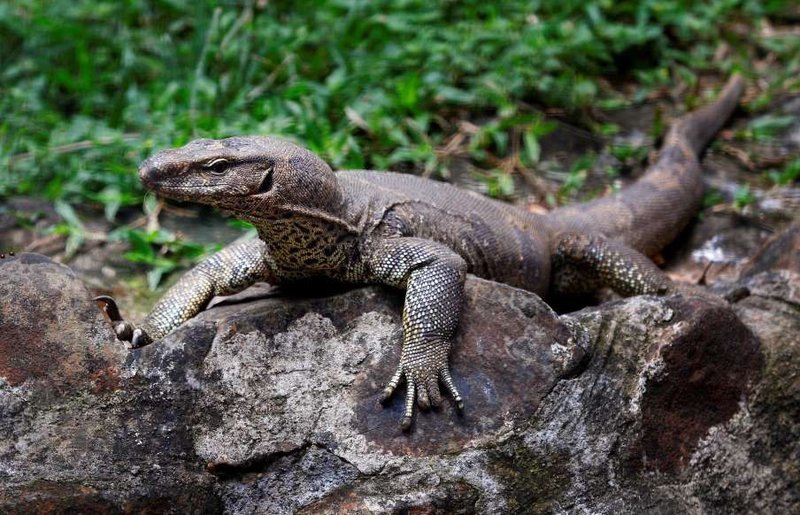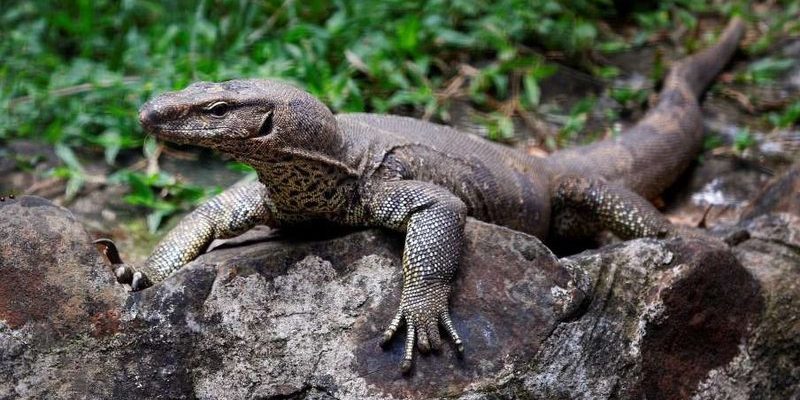
Now, you may be wondering what exactly these adaptations are. It’s not just about their long tails or sharp claws. The secret lies in their behaviors, physical features, and clever strategies. Let’s dive deeper into how these remarkable reptiles manage to survive against the odds in places that can be as unforgiving as a barren desert or as humid as a jungle.
Physical Adaptations of Monitor Lizards
Monitor lizards are like nature’s little survivalists, equipped with a range of physical adaptations that help them thrive. First off, their scales serve a critical purpose. These tough, protective layers not only shield their bodies from predators but also play a role in regulating temperature. In hotter regions, scales can reflect sunlight, helping them maintain a comfortable body temperature. So, when the sun scorches down, the lizard can relax without overheating.
Another key feature is their long, forked tongues. This isn’t just for show; it’s a vital tool for hunting and sensing their environment. By flicking their tongues in and out, monitor lizards can pick up scent molecules from the air, kind of like tasting the atmosphere. This ability helps them locate prey or detect potential dangers. Imagine walking into a party where you can smell desserts from a mile away—that’s how these reptiles can track down a meal!
Last but not least, their strong legs allow them to climb trees and navigate rocky terrains with ease. Whether they need to escape danger or find a sunbathing spot, their powerful limbs are up to the task. They can sprint quickly if they need to flee, showing just how versatile and resilient they are in various conditions.
Behavioral Adaptations That Aid Survival
Beyond their physical traits, the way monitor lizards behave also plays a significant role in their survival. For instance, many species are semi-arboreal, which means they spend a lot of time in trees. This behavior not only provides them with a vantage point to spot prey but also allows them to escape ground predators. Think of it like going to a treehouse when there’s a storm—it’s a safe haven.
These lizards also exhibit a behavior known as basking. By sunbathing on warm rocks or branches, they absorb heat to regulate their body temperature. This is essential, especially for cold-blooded reptiles like them. If you’ve ever felt the warmth of the sun on a chilly day, you understand how important it is to soak up that heat. Monitor lizards know how to make the most of it!
When it comes to hunting, monitor lizards are both patient and strategic. They often employ a method called ambush predation. This means they’ll quietly wait in one spot, using their camouflaged skin to blend in with surroundings. When prey comes close enough, they strike with lightning speed. It’s like being a ninja in the animal kingdom—silent, observant, and suddenly in action!
Diverse Diets: What Do Monitor Lizards Eat?
One of the most impressive survival strategies of monitor lizards is their diverse diets. They are opportunistic feeders, which means they’ll eat whatever is available, from insects and small mammals to birds and even reptiles. This flexibility allows them to adapt to different environments.
In areas where food sources are abundant, monitor lizards may dine on larger prey. However, in harsher conditions where food is scarce, they’ll turn to smaller creatures or even fruits. This adaptability is crucial for survival. Imagine if you could eat whatever you found in your pantry—those with a varied diet would thrive!
Interestingly, some species of monitor lizards are also known to scavenge. They’re not shy about raiding the leftovers of other predators. This scavenging behavior allows them to make the most of their environment and find food without expending a lot of energy. It’s like finding leftover pizza in the fridge when you’re too tired to cook!
Water Conservation Techniques in Arid Environments
When it comes to surviving in arid environments, monitor lizards have some clever tricks up their sleeves. These lizards are experts in water conservation. For example, they can go extended periods without drinking water, thanks to their ability to extract moisture from their food. When you think about how we might feel parched without water for a day or two, it’s impressive that these lizards thrive even in dry spells.
Additionally, monitor lizards often seek out shady spots during the hottest parts of the day to avoid overheating. They know when to roam and when to rest. This behavior is crucial for maintaining hydration levels and overall health. Imagine finding your favorite park with plenty of trees—a great place to escape the sun while enjoying a picnic!
In some cases, monitor lizards have been observed utilizing seasonal water sources. They’ll migrate toward areas where rain collects or where water pools during the wet season. This way, they can take advantage of resources that other animals might not have access to. It’s like knowing when and where to go for the annual company picnic—planning ahead pays off big time!
Defensive Strategies Against Predators
Monitor lizards don’t just rely on their physical size to fend off predators; they’ve got a few tricks to keep themselves safe. First, many species possess a strong bite. Their powerful jaws can deliver a nasty nip to any intruder, which is often enough to send a would-be predator packing. It’s similar to carrying pepper spray—you hope you don’t need it, but it’s great to have just in case!
Another interesting defensive strategy is their ability to run and climb quickly. If danger approaches, they’ll dart away and make a beeline for safety, often seeking refuge in trees or rocky outcrops. It’s like having an emergency escape route planned out before things get hairy.
Some monitor lizard species also employ mimicry and camouflage. By blending in with their surroundings, they’re less likely to be noticed by predators. This strategy reminds me of a game of hide-and-seek, where the best hiders win. So, they stay still, playing the waiting game until the “seeker” has passed.
Unique Habitats of Monitor Lizards
Monitor lizards are found in a variety of habitats, from tropical rainforests to arid deserts. Each species has adapted to its environment, showing incredible versatility. For instance, the Asian water monitor thrives in wetlands and mangroves, often found near rivers and lakes. They are brilliant swimmers, using their powerful tails to propel themselves through the water as easily as a fish.
On the other hand, the savanna monitor calls dry, open areas home. These lizards have adapted to search for food in the grasslands, where they utilize their keen sense of smell to locate prey. It’s like being a detective in a vast open field—the clues are everywhere, and the hunt is always on.
Additionally, there are desert-dwelling monitor lizards, like the black-throated monitor, which have evolved to withstand extreme temperatures. They dig burrows to escape the heat of the day and emerge at dusk when it’s cooler. This behavior highlights how they’ve learned to make the most of their surroundings, just like we might take a stroll in the evening to enjoy a break from the heat.
Monitor lizards are a perfect example of how adaptability can be key to survival. With their unique physical features, clever behaviors, and diverse diets, they manage to thrive in environments that would challenge many other species. Whether they’re basking in the sun, climbing trees, or hunting for food, these lizards continuously show resilience and resourcefulness.
So, the next time you see a monitor lizard, take a moment to appreciate its incredible adaptations. After all, in a world full of challenges, these reptiles have mastered the art of survival. Just like us, they’ve got tricks up their sleeves (or rather, scales on their bodies) that help them navigate life, no matter how tough the terrain might get. Isn’t nature amazing?

